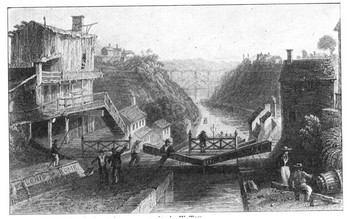With the Louisiana Purchase, the United States doubled in size. This huge land deal also doubled the American people's desire for exploration and commerce. By the beginning of the 19th Century, the U.S. included much more than the original 13 Colonies. Kentucky and Tennessee were now states, as was most of the former Northwest Territory, the area around some of the Great Lakes. This area, in particular, was a real favorite among settlers, and the populations of the cities in these newly created states grew rapidly. Also at this time, Americans were finding new ways to travel. The railroad was still in its infancy. One way that many Americans were finding easier to navigate was water travel. Rivers and lakes were natural waterways that formed boundaries between some states and also connected cities to other ports of call, for both settlers and goods to make their way from place to place.
How the Erie Canal was created and financed is the story of one man's desire and many people's skepticism. Next page > Clinton and His Folly > Page 1, 2, 3 |
|
Social Studies for Kids
copyright 2002–2025
David White



 Emerging technology, mainly the steam engine, enabled Americans to dig their own waterways, canals. Within just a few years, a huge network of canals had sprung up all over the country. One of the largest and most famous of these was the Erie Canal, which linked Lake Erie to New York's Hudson River. When it was completed, goods (and people) could travel, by boat, from Buffalo to New York City.
Emerging technology, mainly the steam engine, enabled Americans to dig their own waterways, canals. Within just a few years, a huge network of canals had sprung up all over the country. One of the largest and most famous of these was the Erie Canal, which linked Lake Erie to New York's Hudson River. When it was completed, goods (and people) could travel, by boat, from Buffalo to New York City.
